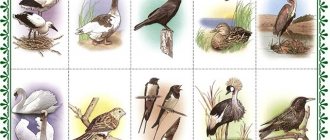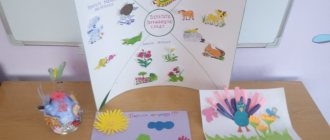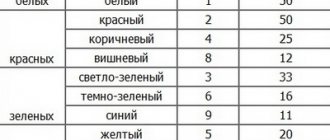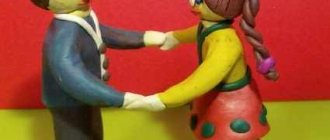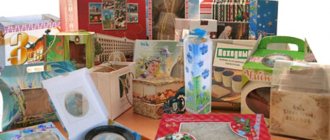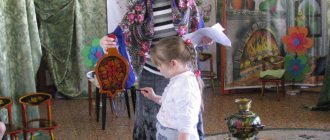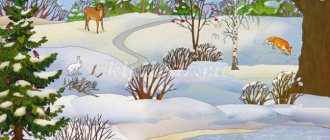Summary of joint activities with children of the preparatory group Topic: “Travel to Africa”
Completed by: teacher of the first qualification category Magadeeva Dilya Shakiryanovna
GBDOU Children's sai No. 41
Frunzensky district, St. Petersburg, Russia
Target:
To give children a basic understanding of the peculiarities of the geographical location of Africa.
Tasks:
- To consolidate children's knowledge about the animals of hot countries, to activate the vocabulary through the use of new words: continent, dunes, savanna (integration of the educational area “Cognition”).
- Continue to introduce the color designation on the globe (integration of the educational field “Cognition”).
- Continue to develop the need for physical activity through the implementation of various motor tasks (integration of the educational field “Physical Education”).
- Expand ideas about how to properly treat plants and animals (integration of the educational field “Safety”).
- To form a culture of relationships between children and consolidate the skill of team interaction (integration of the educational field “Socialization”).
- To cultivate love and respect for nature (integration of the educational field “Socialization”).
Equipment:
Globe, educational game "Sensino", educational game "Cheese Slice", educational game "Zoo from Tarambuco", educational game "Labyrinth", game simulator "Bumps in the Swamp", game simulator "Turtle", interactive board and console "Mimio" , model of trees, sand, figures of animals from hot countries.
Preliminary work:
Getting to know the continent of Africa through reading fiction.
Drawing of animals living in Africa.
Didactic board games: “Who lives where?”, “Inhabitants of hot countries.”
Compose descriptive stories and memorize poems about animals living in Africa.
Progress of the lesson:
Teacher:
- Guys, look at what an interesting item I brought you. Who knows what this item is called? (globe) What is a globe? (small model of planet Earth) Today, I invite you to go on an exciting journey to the hottest continent of planet Earth. What do you think it's called? (Africa)
Slide 1
Teacher:
— That’s right Africa, let’s see where this continent is located (we look at it on the globe, focusing on the desert, shroud and river). How far Africa is from us, but I have a magic labyrinth that will show us the shortest path, we just need to lay it out correctly.
Educational game “Labyrinth” (child makes way)
Teacher:
- Well, guys, now we know the route, but how do we get there? I offer you an unusual transport - high-speed turtles.
Relay race by teams (game simulator “Turtle”)
Teacher:
- Well done, we did it all! Did you all get there?
Slide 2
Teacher:
Guys, look at the screen! What do you think is shown here? (Planet Earth) That's right, this is our planet! Planet Earth is unique! You and I must protect and defend our Earth. Preserve her beauty.
Slide 3
Teacher:
- Guys, let's look at the globe. Africa is painted in different colors, beige and green, and there are blue lines. What do you think the color beige means? (Sand) That's right, sand. What is the name of the area where there is a lot of sand? (Desert) Well done! We are now in the Sahara Desert. The Sahara is the largest desert in the world. It almost never rains here. Hot winds blow and therefore sandy dune mountains are formed. I invite you to watch how this happens.
Experimenting with sand (we form sand mountains).
Slide 4
Teacher:
— We set off further, the desert is behind us and Savanah is in front of us. Many animals live here. Some of them are difficult to notice right away, why do you think? (Camouflage) Correctly, when hunting, they need to camouflage. Let's look for them.
Educational game Sensino (find an animal by touch based on the model and tell about it)
Slide 5
Teacher
:
“Well done, they found all the animals and told us about them all.” Guys, what do you think the blue winding lines on the globe mean? That's right, rivers. Let's move on! And here we are on the banks of the longest river on our planet. It's called Nile. “Kochki” will help us get closer to the river. Our task is to walk over the bumps and not get our feet wet.
Game simulator “Bumps in the swamp”
Teacher
:
What animals do you think come to the river? (Elephants, giraffes, zebras). Well done boys! I have prepared for you to determine from the office which animal came to the watering hole.
Educational game “Zoo” (watering place for animals)
Slide 6
Teacher:
— Africa is a very interesting and beautiful continent, but at the same time very dangerous. It is here, where harsh survival conditions reign, that incredibly strong and dangerous creatures appear that cannot be found anywhere else on the globe. They are fast, strong and dangerous. Can anyone name them? (Cobra, crocodile, elephant, scorpion, lion) Our task is to get through all the dangers to our magic plane.
Educational game "Cheese slice" (
floor and table).
Teacher:
Slide 7
— Guys, Africa is so big, and there are so many interesting things here, but it’s time for us to return. We will fly back on a magic plane. Countdown 10,9,8,7,6,5,4,3,2,1 start. Well, here we are at home. Let's remember where we have been? (continent of Africa) What did you like? What do you remember? On the bank of which river did we visit? (Neil) What animals did we meet? (Crocodile, Leo, Scorpio) I propose to reproduce my little Africa with you.
Group work of panels Africa.
Teacher:
— What soil predominates in the desert? (Sand)
What plants are typical for Africa? (arrange the tree layout)
What animals live there? (we arrange figures of animals from hot countries) What is the longest river in the world, flowing in Africa? (lay out the river)
What dangers lie in wait? (we place dangerous animals).
Completed by: teacher of the first qualification category Magadeeva Dilya Shakiryanovna GBDOU Children's school No. 41 Frunzensky district, St. Petersburg, Russia
Date modified: August 17, 2014 Date published: February 13, 2014
Synopsis of GCD for children of different age groups in kindergarten. Animals of Africa
Abstract of the educational activity for children of different age groups “Animals of Africa”
Author: Natalya Gennadievna Botalova, teacher of the preschool group of the Zaozersk secondary school, Uglich district, Yaroslavl region. Description: the lesson notes are intended to familiarize children of different age groups with the flora and fauna of Africa and the features of the continent. The material will be useful for educators working in a mixed-age group, as it is constructed taking into account the characteristics of work in this group. Goal: to expand children's knowledge about animals of hot countries. Objectives: Educational: - clarify and broaden children’s horizons about natural areas and animal life in Africa; Children of the younger subgroup are taught to name animals and their babies; - for children of the middle and older subgroups to form ideas about the relationships of living organisms with their environment; - improve the dialogical form of speech; - continue to learn to express your own opinions. Developmental: - develop cognitive interest in representatives of wildlife; — develop attention when solving creative tasks. Educational: - cultivate interest in the world around us, the ability to listen and complement each other’s answers; - cultivate a respectful attitude towards nature and animals. Integration of educational areas: cognitive - speech development, artistic - aesthetic development, social - communicative development. Equipment and materials: globe, presentation depicting natural areas of Africa; visual - didactic aids on the topic, a set of toys “animals of Africa”, silhouettes of zebras for drawing, drawings of animals for cutting out by children of the older subgroup, an image of the continent of Africa, a layout for play activities “Africa”; recording songs. Methods and techniques: verbal, visual, practical.
Course of the lesson
1. Introductory part. Children stand in a circle. Educator. Children, tell me, what is your mood today? I'm good because I'm glad to see you. The teacher puts his palm, the children share their mood and put their palm on the teacher’s palm.
- We are visiting today... Let's greet our guests and give them a good mood.
Children imagine that they are releasing a good mood from their palms.
- Guys, but I know that today one little elephant is in a bad mood.
He was so sad that he even hid. Let's call him. - He’s not coming, let’s look for him. 2.Introduction to the topic. Children are looking for a little elephant.
— Do you want to ask him something?
Children make assumptions about the cause of their bad mood by asking leading questions (starting with children in the younger subgroup).
The teacher leads the children to the conclusion that the baby elephant is lost.
- Suggest how we can help him. —Where can a baby elephant live? (at the zoo, in toys, in fairy tales). The teacher leads the children of the older subgroup to the name of the continent of Africa.
The continent lies large, the hottest and driest.
It's summer there all year round. Who will call him for me? (Africa) Baby elephant. Yes, I remembered - my homeland is Africa. Educator. I know that you really love to travel. Which continents have you already visited? I suggest you go to Africa to help a baby elephant. But where is Africa? How can we find out (from a map, from a globe). The teacher puts a globe on the table.
- What is a globe?
(reduced model of the Earth). - Let's mark on the globe where we have already been (In the Arctic and Antarctica). — Guys, where is the continent of Africa? Show it on the globe. - How do we get to this distant country? (children offer possible answers) - Baby elephant, don’t be sad, we will help you. Let's fly by plane, relax during the flight, and answer the question: which fairy-tale characters have already visited Africa? (Dr. Aibolit). Dynamic pause "Airplane".
At this time, a musical fragment about Africa plays.
Children sit on chairs. 3. Main part. Getting to know the nature of Africa.
- What do you know about Africa? (children’s answers) And imagine what Africa is.
Showing a presentation or visual demonstration material “Natural areas of Africa”
- It’s warm here all year round.
In summer there is drought and in winter it rains. 1. “Desert... All around are either yellow, small, soft, powdery sands, or gray, weathered stones. The sultry sky breathes heat. No water, not a bush of greenery. This is Africa. 2. Where sources of water emerge on the surface of the earth, the desert is transformed. These are oases. Date palms, fruit trees, grapes, and vegetables grow in them. 3. And next to it is a solid wall of tropical forest: trees, bushes, vines. The leaves on them are thick and juicy. Birds fly that look like magical flowers. It's always gloomy and humid here. You can hear the roar of predators and the screeching of monkeys. This is also Africa. 4. But the forest is becoming less and less common. It gives way to savannah. Savannah is endless steppes covered with tall grass. Among the savannah there are huge trees - giant baobabs (several meters in girth). Their fruits are edible. Monkeys love them very much. Along numerous rivers there are dense thickets with fresh greenery. These forests are called gallery forests. They remain green even under the scorching sun. - This is what Africa is like. Educator. Guys, tell me who we didn’t see in these photos? (animals). — Do you want to meet them? Educator. So we arrived. Look, our baby elephant is being met by his mother. What should we call her? (elephant). The mother elephant says that she was very worried about the baby elephant. The elephant and the calf thank the children for their help. Getting to know the animals of Africa. -Guys, what do you know about elephants? Show illustration.
The elephant is the largest and strongest animal in Africa, even a lion cannot cope with it.
The most amazing thing about an elephant is its trunk. What is he doing to them? (plucks leaves from trees, tears grass, drinks, carries thick trees. The elephant uses its trunk to protect itself from enemies, expresses tenderness, strokes its baby with its trunk). Elephants sleep standing up, only sometimes the cubs lie on their sides. In hot weather, the elephant fans itself with its large ears like a fan. The baby elephant and mother elephant introduce the children to their friends and give the children of the younger subgroup a set of African animals. Children name animals and their cubs (lion-lion, monkey-baby monkey, zebra-zebra or foal, camel-camel, elephant-elephant, giraffe-baby giraffe, hippopotamus-baby hippopotamus). — Animals want to play with you. Didactic game “What has changed?” The teacher puts the toys in a row, the children close their eyes, and when they open them, they say what has changed. — How can we make a hot country in our group? (children's answers) Children of the younger subgroup are informed that it is time for them to return to kindergarten, and they, together with the assistant teacher, fly home. As a gift about the trip, they are given a model of Africa, the children go to play with the set of animals. Educator. Our journey continues. Someone is on our way, repeat the movements after me. Physical education minute.
Here comes the thick-skinned hippopotamus to drink.
(hands to the side, we waddle).
And behind him, without knowing laziness.
Fast deer gallop. (Jump in place, depict horns)
Even though there is water with sand and clay, A giraffe with a long neck drinks here
(Bends forward, hands down, depict a giraffe’s neck).
By the river, buried in the silt, a formidable crocodile is dozing.
(Sit down, arms forward, move your arms apart and together, imitate the mouth of a crocodile)
- Guys, guess the riddle.
Here is a living crane, an inhabitant of hot countries. Leaves and bananas are torn from multi-story trunks. (Giraffe) Show illustration.
Conversation about an animal. First, the children tell what they know about the giraffe.
The teacher adds information. The height of the giraffe is 6 meters, it is as tall as a 2-story house (half the height is at the neck). The giraffe cannot be confused with anyone else. He has long legs and a sloping back like a hill. And a long, very long neck. On this neck is a small head with horns. The giraffe looks down on everyone with black eyes covered with thick eyelashes. The giraffe is a very beautiful animal. Its skin is decorated with a pattern of large red or brown spots. And each giraffe has its own unique pattern. - Why does a giraffe have such colorful colors? (She hides it from prying eyes. The bright glare of the sun, the openwork shadow of the trees hide the contours of the body of long-necked animals). - Why does a giraffe have a long neck? Thanks to its amazing neck, the giraffe plucks leaves from the highest branches of trees. His long tongue helps him with this. He is not afraid of thorns or sharp thorns. And they rarely eat grass. To bend down, the giraffe has to spread its front legs wide apart or kneel down. This is how giraffes drink water from a pond. While one drinks, the other watches carefully: is there danger? And he sleeps standing up. And very little. Giraffes graze in small herds. And often - with antelopes, zebras, ostriches. Nobody offends anyone. Giraffes will be the first to notice danger - they can see everything from above! - and they will warn the others. But with a blow from a hard hoof, a giraffe can knock down a lion - its main enemy. Giraffes run fast and can easily jump over high obstacles. They have good eyesight, smell and hearing. Now these amazing creatures of nature are protected in nature reserves. — What is a reserve? What kind of animal is this? (zebra) - Who will write a riddle about zebras? A zebra is a striped horse. Why does she need such a strange, striped outfit? Conspicuous coloring helps zebras recognize each other from afar. And, unsurprisingly, black and white stripes can deceive an attacking enemy. A zebra was attacked by a lion. One zebra is clearly visible. What if she runs to her herd? There are a lot of zebras there, and all the stripes merge, it dazzles your eyes... It seems that the herd has turned into some kind of strange, huge beast. Zebras eat grass. In search of new pastures and watering holes, they make long journeys across the sun-scorched savannah, where only bushes and trees grow here and there. Antelopes, ostriches and even giraffes often graze together with zebras. With such a large group it is easier to escape from enemies. A zebra knows how to stand up for itself. She tries to hit the enemy with her front legs with hard hooves, and even bite with her teeth. Her character is hot-tempered. A herd of zebras and the king of animals, the lion, can win. The baby foal recognizes its mother by the stripe pattern. It never repeats itself. And so that the baby remembers his mother well, she will not let anyone near the foal in the first days. Children in the middle group are asked to draw stripes on their zebras. Children in the middle group fly away from the lesson with their assistant teacher. Educator. - Children, guess the riddle. I am a hunchbacked beast, I live in the desert, I carry luggage to distant lands. (Camel) Camels are ruminant mammals that live in the desert. By storing fats in its single or double humps, this animal can travel great distances without eating or drinking. Camels have two rows of long, thick eyelashes that protect their eyes from sandstorms. Contrary to popular belief, camels do not store water in their humps. Water is stored in their blood, which allows them to go for several days without water or food. The camel is called the ship of the desert because. it is a means of transporting people and goods in the desert. The camel feeds all year round on scanty grass and camel thorns, which no animal can eat. A camel can go without water for several days. Educator. Early in the morning, monkeys frolic on the vines in Africa. Children jump up and down, imitating the movements of monkeys.
- Oh, look.
I saw how the animals went to drink. What is a watering hole? Who can come to a watering hole? (giraffe, zebra, lion) - Who lives in water almost all the time? (hippopotamus, turtle, crocodile) - What animals of Africa have we not named? —Where can you find out about them? (read in a book, ask adults, find information on the Internet). The teacher asks the children to prepare reports about animals. Educator. - Guys, it's time for us to go home. Bottom line. - What did we do today? (helped the baby elephant, learned about the nature of Africa, about animals). — What do you remember most about the trip? — What will we bring as a gift to our kids? — What animals will you tell your younger friends about? Productive activity. Educator. In memory of the fact that we traveled to Africa today, let's populate this continent with the animals that live here. Children cut out animals and glue them onto a picture of the continent.
- Let's say goodbye to the continent of Africa.
Exercise “Airplane” (children perform exercises in accordance with the text).
We put our hands all together. A plane appeared. Swing your wing back and forth, Do “one” and do “two”. Hold your hands to the sides, look at each other. Our plane landed and landed in kindergarten. Children of the junior and middle subgroups are invited, children of the older subgroup show collective work, where children of the middle group can glue their drawn zebras.
We recommend watching:
Summary of a lesson on application in the middle group. Snowman Summary of educational activities for “Familiarizing children with the world around them” in the middle group. A story about a badger for preschool children About a hippopotamus for children 6-7 years old
Similar articles:
Poems about wild animals for kindergarten
Coloring pages for children 5-7 years old. Forest dwellers
Coloring pages “Pets” for children 3-4 years old
Conversation about the hare for older preschoolers
What can you tell children about a hedgehog?
ECD lesson “Amazing Africa” (based on the fairy tale “Barmaley” by K. Chukovsky) in the senior group
ECD lesson “Amazing Africa” (based on the fairy tale “Barmaley” by K. Chukovsky) in the senior group
Author: Davydova G.S., teacher of the preschool group of the Municipal Budgetary Educational Institution “Akhmatovskaya Secondary School”
of the Alatyrsky District of the Chuvash Republic,
NGO “Speech Development. Perception of fiction", "Cognitive development. Formation of elementary mathematical concepts ."
OO integration:
“Cognitive development. Formation of a holistic picture of the world”, “Artistic and aesthetic development”, “Physical development”, “Social and communicative development”.
Target
:To form in children an emotional and figurative perception of K. Chukovsky’s work “Barmaley”.
Tasks:
Educational objectives:
1) Introduce the work of K.I. Chukovsky “Barmaley”.
2) Fix the composition of the number 6 from two smaller ones using Denesh blocks.
3) Practice the ability to classify sets according to three properties (color, shape, size).
4) Update and deepen children’s understanding of some animals in Africa, and the rules of safe behavior when communicating with them; help remember the natural objects of the African continent: the Nile River, pyramids, jungles.
5) Learn to make beads from non-traditional material (pasta).
Developmental tasks:
1) Continue through thoughtful listening to fairy tales to form in children an emotional and figurative perception of K. Chukovsky’s work “Barmaley.”
2) Develop mental operations of systematization and generalization, the ability to model in games with Dienesh blocks
3) Develop attention, memory, imagination, speech, creativity, observation, cognitive interest.
4) Improve the desire to express your thoughts, prove your judgments with the help of precise and clear speech, promote the development of coherent (dialogical and monological) speech; activation of the dictionary: Nile, pyramids, jungle, airplane.
Educational tasks:
1)
To help maintain interest in the works of K. Chukovsky, in educational games with Dienesh blocks.
2) Foster curiosity and interest in Africa as a continent, in the nature and inhabitants of the African continent.
2) Cultivate empathy, compassion, respect for each other, the desire to help, teach obedience, kindness, responsiveness.
4) Develop the ability to work individually and in a team, cultivate initiative, perseverance in achieving goals, and independence.
Equipment:
Video and audio support; presentation for the lesson, audio recording of the song “Chunga-Changa” (music by M. Dunaevsky, lyrics by Yu. Entin); author’s physical education lesson with animation effect “This is how Africa is.”
Material: Demo:
Illustrations for K. Chukovsky’s fairy tale “Barmaley”, illustration with the image of pyramids, figure of a pyramid, magnetic board, Dienesha blocks, planar images of Dienesha blocks, physical map of the world and the African continent, political map of Africa, silhouettes of 6 African animals, poster “Composition of the number 6” ", numbers 1-6, ball.
Handout
: sets of Dienesh blocks (for each child), sheets of cardboard, yellow, red and blue pasta, cords, “African Animals” coloring pages.
Previous work:
didactic games with Dienesh blocks, individual work with children with slow development, conversations about Africa, looking at illustrations depicting objects of nature and wildlife in Africa, reading the book by K. Chukovsky “Aibolit”, D. R. Kipling “Like a Leopard” got my spots”, encyclopedia “I Want to Know Everything” (section on Africa).
